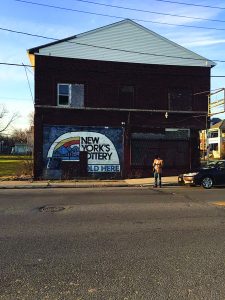by Matt Ricchiazzi
It was 15 years ago when then Governor George E. Pataki – seeking reelection to his third term – promised to transform Niagara Falls. The crux of his revival plan rested in a 2001 casino compact with the Seneca Nation of Indians that granted the Nation sovereign jurisdiction over 50 acres of the city’s most prime downtown real estate. Despite the Senecas’ $1.2 billion in revenue sharing payments made to the State of New York and the City of Niagara Falls since, the city remains chronically blighted and without the catalytic development that was promised.

Seneca claims it needs a tax free gas station but this taxpaying gas station could not survive near the Seneca
In reality, the casino failed to attract the swoons of tourists, spinoff development, and vibrancy that were once imagined.
Instead, potholes adorn the streets; empty storefronts still litter the cityscape; and abandoned houses still provide the unsightly welcome for which the city is known.
It doesn’t take a genius to realize that those promises were not only foolish, but a deeply disingenuous ploy designed to bestow extraordinarily lucrative regulatory arbitrage opportunities on a cadre of politically connected deal makers.
The joke has been entirely on us – and the casino isn’t the only government granted monopoly in town.
The eight million tourists who come here every year drive into Niagara Falls State Park on the Moses Parkway; park on one of the State’s 1,500 parking spaces; ride Glynn’s Maid of the Mist; eat at Delaware North food stands and Top of the Falls restaurant; purchase gifts and souvenirs from one of several shops in the former nature preserve; and then leave on the same parkway, without having any need or reason to enter or spend money in the City of Niagara Falls.
As you read this, work on the state’s $50 million upgrade of Niagara Falls State Park takes us in exactly the wrong direction. Expanded parking, food service, and gift shop facilities are being rushed to completion in anticipation of the millions who will come to visit this summer.
We can be sure that Glynn and Delaware North will profit handsomely from our spending.
Meanwhile, the city of Niagara Falls’ so-called Third Street “tourism district” (if you could call it that with a straight face) is looking more than a little shabby, with less than a month remaining before the official tourism season gets underway.
Back in 2005, USA Niagara and the city jointly spent $3.7 million on streetscape and other infrastructure “improvements” to the Third Street corridor, such as “replacement of the water mains, reduction in the size of traffic lanes to allow for widened sidewalks; the planting of trees along the promenade to drive foot traffic; the identification of gateways to the area; and the installation of special markers, new lighting and street furniture.”
While Third Street does feature a few intrepid shopkeepers and assorted small businesses such as a pizzeria, liquor store, and a couple of restaurants – rendering it virtually indistinguishable from the Main Street of any small town – it does little more than play host to one or more festivals and events during the peak tourist months.
The lofty goals of a decade ago appear largely unmet.
Our city’s so-called revitalization continues to be just another cruel joke perpetrated on a city that has been systematically deprived of its waterfront assets by Albany and the worthless local government officials who doing little more than genuflect.
































